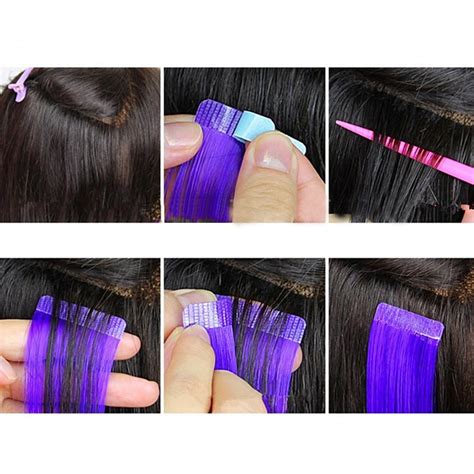Are you considering tape-in hair extensions but unsure of what to look for? Look no further! This comprehensive guide will provide you with everything you need to know about tape for extensions, from the basics to the latest advancements.

What is Tape for Extensions?
Tape for extensions is a type of hair extension that is applied using a double-sided adhesive tape. Unlike other types of extensions that require heat or glue, tape-in extensions are quick and easy to apply, making them a popular choice for people who want to add length and volume to their hair without damaging it.
Types of Tape for Extensions
There are two main types of tape for extensions:
- PU Tape: PU tape is made from polyurethane, a durable and flexible material that is gentle on hair. It is suitable for all hair types, including fine hair.
- Silicon Tape: Silicon tape is made from silicone, a waterproof and heat-resistant material. It is ideal for people who frequently swim or use heat styling tools on their hair.
Benefits of Tape for Extensions
- No damage: Tape-in extensions do not require heat or glue, which means they will not damage your natural hair.
- Quick and easy: Tape-in extensions can be applied in as little as 30 minutes, making them a convenient option for busy people.
- Versatile: Tape-in extensions can be used to add length, volume, or color to your hair. They can also be styled as you like.
- Long-lasting: Tape-in extensions can last up to 12 weeks with proper care.
How to Choose the Right Tape for Extensions
When choosing tape for extensions, there are a few things to consider:
- Hair type: The type of tape you choose will depend on your hair type. If you have fine hair, you will need a tape that is gentle on your hair, such as PU tape. If you have thick hair, you can use either PU or silicon tape.
- Lifestyle: If you frequently swim or use heat styling tools on your hair, you will need a tape that is waterproof and heat-resistant, such as silicon tape.
- Budget: Tape for extensions can range in price from $100 to $500 per pack. The price will depend on the quality of the tape, the length of the extensions, and the brand.
How to Apply Tape for Extensions
Applying tape for extensions is a relatively simple process, but it is important to follow the instructions carefully to ensure that the extensions are applied correctly and securely.
- Prepare your hair: Wash and dry your hair thoroughly. Do not use any conditioner or styling products.
- Section your hair: Divide your hair into small sections, about 1-2 inches wide.
- Apply the tape: Peel off the backing of the tape and apply it to the underside of a small section of hair, about 1 inch from the root.
- Sandwich the hair: Place another piece of tape on the other side of the extension, sandwiching your natural hair in between.
- Press down: Use a hair crimper or flat iron to press down on the tape and seal it around your hair.
- Style your hair: Once the extensions are applied, you can style your hair as you like.
How to Remove Tape for Extensions
Removing tape for extensions is also a simple process, but it is important to do so carefully to avoid damaging your natural hair.
- Apply remover: Apply a tape remover solution to the tape bond. You can purchase a tape remover solution at most beauty supply stores.
- Loosen the tape: Use your fingers or a comb to gently loosen the tape bond.
- Slide the extensions out: Once the tape bond is loose, slide the extensions out of your hair.
- Wash your hair: Wash your hair thoroughly to remove any residue from the tape remover.
Common Mistakes to Avoid
Here are a few common mistakes to avoid when using tape for extensions:
- Applying the tape too close to the root: This can cause the extensions to slip out of your hair.
- Not pressing down on the tape hard enough: This can cause the extensions to fall out.
- Using too much tape: This can make your hair look bulky and unnatural.
- Not removing the extensions properly: This can damage your natural hair.
Pros and Cons of Tape for Extensions
Pros:
- Quick and easy to apply
- No damage to natural hair
- Versatile
- Long-lasting
Cons:
- Can be expensive
- May not be suitable for all hair types
- May require regular maintenance
Conclusion
Tape for extensions is a great way to add length, volume, or color to your hair without damaging it. When choosing tape for extensions, it is important to consider your hair type, lifestyle, and budget. By following the instructions in this guide, you can apply and remove tape for extensions safely and easily.
